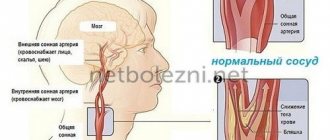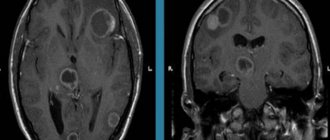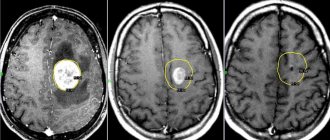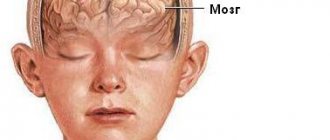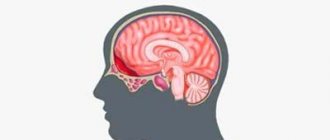Causes
Cerebrovascular diseases appear for the following reasons. Not enough physical activity on the body . Muscle tissue sag and lose shape. A similar process occurs with blood vessels. If the heart muscle does not tense sufficiently, its tone is lost and the movement of blood throughout the body becomes difficult.
Nutrition problems . Regularly increasing calories has a difficult impact on your health. Veins and arteries filled with cholesterol have problems performing their functions. Each new kilogram in the body requires the formation of several meters of blood vessels. For this reason, blood pressure often decreases.
Bad habits . The fibers of veins and arteries atrophy under the influence of alcoholic beverages; under the influence of alcohol, blood clots are created, due to which the cavities are stretched. Long-term abuse of strong alcohol causes individual personality degradation, in addition to addiction.
Regular stress . In modern society, stressful situations are as harmful as cigarettes. Not everyone’s blood vessels can withstand such a load, so many people with increased nervousness experience numbness in their arms and legs, feel dizzy, and lose consciousness.
Problems with sleep and rest have become more frequent recently . People have more and more working hours. Poor sleep does not allow you to restore vital energy. This negatively affects the condition of the veins and arteries, and there are no clear symptoms indicating serious problems.
These are the main reasons, but pathologies of the blood vessels of the head may be due to poor heredity.
Symptoms
Among the symptoms of cerebral atherosclerosis are:
- Certain signs of cerebral atherosclerosis include the following symptomatic picture:
- Sleep problems: insomnia, disturbing dreams, difficulty getting up and problems falling asleep again;
- Loss of sensation in half of the body;
- Severe, frequently recurring headaches;
- Increased cholesterol levels in blood tests:
- Changes in gait and loss of coordination;
- Changes in vision, flickering of “spots” before the eyes, tinnitus;
- Emotional changes: irritability, depression, tearfulness and anxiety;
- Hot flashes and sweating of the face;
- Increased fatigue, constant weakness and absent-mindedness;
- Trembling of the chin and limbs;
- Memory impairment, problems with short-term memory;
- The appearance of facial asymmetry. Source: L.S. Bizhanova. Ischemic brain disease // Bulletin of KazNMU, No. 2, 2015, pp. 241-242 Shabir O.
Clinical signs do not appear immediately. This happens long after cholesterol has begun to be deposited. Symptoms appear after the lumen of the arteries and capillaries of the brain narrows so much that 15% or more less blood begins to flow to the organs.
Signs of the disease depend on the stage:
1. In the first stages, the disease makes itself felt only after physical or emotional stress and quickly passes when the patient goes into a state of rest. The main symptom is asthenia, accompanied by fatigue, weakness, decreased alertness, and general lethargy. Rarely, sleep is disturbed, insomnia or daytime sleepiness occurs. Mostly, patients complain of headaches, tinnitus, and memory impairment. In the latter case, patients remember the past well, but do not remember new information well.
2. As the disease progresses, anxiety, suspiciousness, depression, and mood swings appear. Memory impairments become more pronounced, to the point that the patient does not remember what happened to him today. There is a constant headache and noise in the ears, speech is persistently impaired - it becomes unclear, diction changes, patients feel dizzy and have unsteady gait. Hearing and vision also deteriorate, limbs and head shake, and a person stops thinking logically and clearly.
3. At the last stage of atherosclerosis, dementia develops; the patient may behave like a child or become aggressive and tearful. Most people completely or partially lose their memory and cease to be interested in the world around them and the events in it. The ability to navigate in time and space is lost, the patient needs constant care because he loses self-care skills in everyday life. This stage is irreversible.
Signs of vascular diseases
The symptoms of the disorder depend on its location. When you constantly have a headache and feel worse in stuffy rooms, it means the person has problems with the blood vessels in the head. Symptoms are divided into two subcategories.
Are common:
- Accelerated fatigue
- Long-term depressive states.
- Memory deteriorates.
- Poor tolerance to dry or extremely hot conditions.
- Blood pressure fluctuates, tachycardia appears with little physical exertion.
Local:
- Migraine, feeling of pulsation in the head, confusion of consciousness.
- In the arms and legs, the blood vessels dilate, a tingling sensation, numbness appears, sweating increases, pain appears during physical activity, and swelling appears.
- Painful sensations and tingling in the chest area.
- Capillaries in the ENT area burst and bleed.
Regardless of the indicated symptoms, the reasons for the worsening health condition may vary. For this reason, you should not neglect going to the doctor for diagnosis. This will help avoid the following diseases: atherosclerosis, VSD, stroke, migraine. This is only part of the diseases that are caused by problems with the functioning of blood vessels.
Diseases of the cerebral vessels in the first stages are asymptomatic, so patients turn to doctors with advanced disorders. All difficulties lie in blockage and narrowing of blood vessels:
- Stage 1 . Increased fatigue, noticeable dizziness, drowsiness, problems with concentration.
- Stage 2 . Memory noticeably deteriorates, the patient cannot concentrate on anything, migraines appear regularly, the gait is uncertain, the person constantly staggers.
- Stage 3 . Dementia begins, the patient cannot control his actions and reflexes.
When the disease is too advanced, it will not be possible to get rid of it. After prolonged oxygen deprivation, neurons die and are excreted from the body in urine. Therefore, this process is irreversible.
Headache
Encephalitis
Tick-borne encephalitis
Polio
Hypercholesterolemia
19013 July 31
IMPORTANT!
The information in this section cannot be used for self-diagnosis and self-treatment.
In case of pain or other exacerbation of the disease, diagnostic tests should be prescribed only by the attending physician. To make a diagnosis and properly prescribe treatment, you should contact your doctor. Headache - causes, what diseases it occurs with, diagnosis and treatment methods. The basis of headaches is irritation of pain receptors located in:
- dura mater and cerebral vessels;
- periosteum of the skull, vessels of the soft tissues of the head, muscles.
The brain tissue itself does not contain pain receptors.
Types of headaches (cephalgia)
Headaches are divided into primary and secondary. A headache is considered primary if it is the main manifestation of a brain disease, such as in migraines and tension headaches.
Secondary headache is a symptom of other disorders, for example, head trauma, chronic cerebral ischemia, viral diseases, diseases of the cervical spine, etc.
Let's look at the four most common types of headaches.
Possible causes
Tension headache
Tension headache is the most common form of primary headache. Psycho-emotional stress, depression, anxiety and various phobias, overstrain of the muscles of the shoulder girdle - these are the main causes of tension headaches. Migraine headache
Migraines occur in women about three times more often than in men, and about 60-70% of all migraine cases in women are so-called menstrual migraines. However, the causes and mechanism of development of migraine attacks are not completely clear. At any age, in both men and women, migraine attacks can be provoked by emotional and physical overload, eating disorders, drinking alcohol, changes in weather conditions, sharp noise, strong odors, etc. Headache with colds
Headaches from colds are caused by hyperthermia and the damaging effects of microorganism toxins on brain cells. Headache in chronic cerebral ischemia
The cause of this pain, which is the most common secondary headache in elderly patients, is cerebral vascular pathology, in which blood circulation is disrupted and blood supply to brain tissue deteriorates.
The result is progressive brain dysfunction.
What diseases cause
tension headaches?
Tension headaches are caused by irritation of structures in the central nervous system (CNS) called the nociceptive system. Myogenic, stress, and psychogenic headaches are tension headaches.
Most often, tension headaches occur at a young and working age.
In cases of tension headaches, a person experiences bilateral, usually not strong, pressing and squeezing, monotonous and dull headaches. Attacks of such pain are accompanied by fatigue, nervousness, impaired appetite and sleep, and decreased performance. The duration of the attack is from 30 minutes to several days.
Migraine headache
Indicates only one disease - migraine, since attacks of such cephalgia have a peculiar character. Migraine pain is paroxysmal, throbbing, of moderate or severe intensity. It covers half of the head.
The pain may intensify with physical activity, tilting the head, and is often accompanied by nausea and vomiting.
Bright light, sharp sound, strong smell increase the pain. A migraine attack may be preceded by an aura, a collection of visual, auditory, olfactory or other neurological symptoms that lasts up to one hour.
Headache due to colds
Occurs in most acute and chronic diseases of the upper and lower respiratory tract caused by bacteria or viruses. In some cases, the intensity of such cephalgia correlates with the severity of fever, severity of cough, sore throat and other symptoms. The pain most often spreads throughout the head. Headache in chronic cerebral ischemia
The concept of chronic cerebral ischemia includes: discirculatory or vascular encephalopathy (slowly progressive cerebrovascular accident), cerebrovascular insufficiency (pathology of cerebral vessels), vascular dementia (a disorder that causes organic damage to the brain). In the clinical picture of chronic cerebral ischemia, dizziness, decreased cognitive function, emotional lability (unstable mood), motor-coordination disorders, and perception disorders (tinnitus, “floaters” before the eyes) become indispensable companions of headaches. Headaches are usually not severe, spread over the entire head, and last for a long time. Diagnostics and examinations
Tension headache and migraine headache, headache with colds
The diagnosis is made by a neurologist based on anamnesis and assessment of the patient’s complaints. Headache in chronic cerebral ischemia
Radiation examination is key for chronic cerebral ischemia (ultrasound Dopplerography of cerebral vessels)
Symptoms of atherosclerosis
Memory problems often indicate poor circulation in the head. When the lumen of blood vessels becomes narrow, blood flow to different parts of the brain is significantly reduced. This causes numerous violations. In addition to memory deterioration, patients experience hearing problems, increased fatigue, and poor coordination of movements.
Insomnia or waking up abruptly at night occurs when blood vessels in the neck and head become blocked. Fatigue in the morning, irritability and sudden changes in mood also require attention . Sugar addiction occurs when a large amount of glucose accumulates in the circulatory system. The brain regards this condition as a lack of micronutrients, carbohydrates and sweet foods.
Atherosclerosis occurs due to problems with hormones that affect the functioning of the sweat glands, the discharge becomes sticky and smells unpleasant. If you experience excessive sweating for no particular reason, you need to check the condition of the blood vessels.
A doctor should be consulted when gray hair appears in people under 40 years of age. When blood circulation deteriorates, problems arise with the synthesis of the protein responsible for coloring the skin and hair. Lack of nutrients causes early gray hair and pale skin . Cold hands, a feeling of heaviness in the limbs when they are lowered down, sometimes cramps appear, itching on the skin - all these are signs of circulatory problems.
Diagnostic procedures
Vascular diseases of the brain are dangerous and require diagnostics in medical institutions. The procedures help to identify emerging pathology at the primary stages. After a detailed study of the etiological picture, the patient is referred to a specific doctor.
The specialist determines the feasibility of carrying out specific types of diagnostics and may prescribe one or a set of tests: MRI, duplex examination, administration of a contrast agent for tomography, blood tests and other biological materials.
Such examinations make it possible to identify the cause of spasms and problems with the functioning of cerebral vessels, and determine the course of treatment for a particular patient. In everyday conditions, such diagnostics are difficult to carry out. Therefore, going to the hospital should not be ignored if suspicious signs appear.
How to get rid of the problem?
To alleviate your condition, the patient needs to:
- Leave the patient alone, give him some motherwort.
- To eliminate headaches, you will have to use analgesics.
- If problems with the blood vessels in the brain continue, you will have to take a warm bath or give your feet a cold one.
- When the above methods do not stop the attack, you will have to consult a doctor for professional support.
- You need to wash your face with cold water.
- Lie down for a while and lay your head on the pillow.
- Massage the back of your head and temples.
- Drink some warm water and honey.
When problems with cerebral vessels appear systematically, it is necessary to determine the real cause that caused the disease. Once it is determined, it is easier to prescribe the correct treatment. The following methods are used: medications, surgery, traditional medicine.
You need to understand that treatment for spasms of blood vessels and other diseases are prescribed taking into account the individual characteristics of the patient.
The following are used in the form of safe medicinal methods for the treatment of mild disorders in domestic conditions: Amitripline, Anaprilin, Afabazole.
Problems with blood vessels imply a loss of elasticity. Therefore, medical procedures are carried out in 3 main directions : the use of drugs that strengthen the walls of blood vessels, thin the blood, surgery, and traditional medicine.
Medicines: drugs that improve lipid metabolism, sedatives, drugs that improve the dilation of blood vessels, drugs that eliminate spasms, anticoagulants, tranquilizers. Among the folk remedies we can mention herbal tinctures and medicinal tea. Gymnastics is one of the auxiliary measures suitable for treatment.
Diagnostics
A neurologist deals with this disease. First, the doctor collects anamnesis, interviews the patient about complaints, and conducts a series of tests. So, the following factors indicate the presence of the disease:
- The patient cannot look up;
- Reflexes are weakened or excessively increased, most often asymmetrically;
- In a standing position, legs together, arms extended forward, the patient cannot maintain balance;
- When the patient stretches his arms forward, his fingers tremble and become weak;
- Closing his eyes, a person cannot bring his finger to the tip of his nose.
These are indirect signs that only allow us to make an assumption about the presence of atherosclerosis. Therefore, a comprehensive examination is then carried out with consultations of other doctors - ENT, ophthalmologist, etc., depending on the existing disorders. At the medical office, you can get advice from related specialists on any disease, including in cases of suspected cerebral atherosclerosis. Source: Berwick J, Francis SE. Neurovascular dysfunction in vascular dementia, Alzheimer's and atherosclerosis // BMC Neurosci. 2021 Oct 17;19(1):62. doi:10.1186/s12868-018-0465-5.
In addition, it is necessary to undergo a biochemical analysis of the blood lipid spectrum (cholesterol, triglycerides, etc.)
List of instrumental studies:
- REG – radioencephalogram;
- Angiography of cerebral vessels;
- Duplex head scanning;
- Ultrasound Dopplerography of cerebral vessels;
- MRI of cerebral vessels;
- CT – computed tomography;
- EEG – electroencephalogram.
The diagnostic capabilities of a medical doctor allow you to accurately diagnose atherosclerosis, the extent of the disease and choose an effective treatment regimen.
Vascular spasms
Let's list the symptoms: often headaches and dizziness, performance deteriorates, fatigue appears, white spots flash before the eyes, tinnitus, nausea, vomiting. Severe symptoms: problems with speech, poor memory, coordination of movements worsens, the patient has poor spatial orientation, faints.
With the rapid development of vasospasm, the symptoms manifest themselves sharply. The signs will be a little milder with chronic spasms, but there may be complications afterwards. Ischemic stroke is a serious problem resulting from blockage of the lumen of blood vessels. The consequences of this disease are serious because too many neurons in the brain die.
Cerebral vasospasm appears in children, ischemia appears. As a result, mental retardation can be observed. If the violations are too serious, blindness, paresis, and neurological diseases appear. Headache becomes a more persistent symptom as you get older.
Treatment of cerebral vasospasm
Therapeutic techniques:
- Give up alcohol, tobacco and other bad habits.
- Stick to the established diet.
- Sanitation of infectious foci taking into account dental treatment.
- Elimination of spasms using calcium.
- Accelerated relief of painful symptoms through injections of Eufillin, Papazol.
- Use of nootropic drugs.
- Means that allow you to correct the functioning of the blood vessels of the head.
- Use of adaptogens.
- Physiotherapeutic procedures.
- You need to massage the collar area.
- Go to sanatoriums.
When treating cerebral vasospasms, it is necessary to follow the system established by the doctor; in order to achieve a sustainable result, you will have to take 2 or more courses.
Prevention
You need to eat right and watch your own weight. In the morning, doctors advise eating whole grain porridge, seafood is suitable for lunch, and vegetables are a must. It is advisable to limit the intake of fatty and dairy products, and reduce the amount of sweets to a minimum .
Doctors often advise giving up fatty foods, fried, canned foods. As for drinks, it is better to give preference to herbal tinctures that can strengthen blood vessels. You need to drink at least 2 liters per day. This makes it possible to avoid stagnation in blood vessels and the accumulation of harmful microelements.
Some traditional medicines help improve blood circulation and have a beneficial effect on the walls of blood vessels. Garlic has a positive effect on the tissue of veins and arteries. The cloves are crushed into a paste, mixed with vegetable oil, and a little lemon juice is added every other day. Use the product in the morning, 1 tea. lie within 3 months.
Physical activity helps strengthen blood vessels and helps maintain their tone. Problems with the veins and arteries of the brain are treated in the primary stages. Often, therapeutic methods involve lifestyle changes, giving up bad habits, regular exercise, and light medications.
Possible risks associated with atherosclerosis
The most dangerous complication is a stroke. If at the same time the patient has poor eating habits, is overweight, moves little and is regularly exposed to stress, then with an 80% probability he will become disabled as a result, unable to care for himself. The mortality rate is also high.
Prevention
To prevent cerebral atherosclerosis, you need to avoid smoking, follow a diet, and keep yourself in good shape with moderate physical activity. It is very important to establish a psycho-emotional background, protect yourself from stress, and if this is not possible, then take courses of sedatives and amino acids, for example Glycine.
| Name of service (price list incomplete) | Price, rub.) | In installments* |
| Appointment (examination, consultation) with a cardiovascular surgeon, primary, therapeutic and diagnostic, outpatient | 1 750 | — |
| Program “Risk of atherosclerosis and ischemic heart disease, predisposition to dyslipidemia” | 19 000 | — |
* You can read more about the conditions here - Treatment on credit or in installments.


